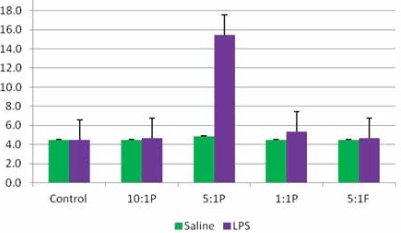



Effects of Altering the Omega-6 to Omega-3 Fatty Acid Ratio in Starter Diets on Piglet Inflammatory Response
Weaner pigs fed diets containing different ratios of n-6 to n-3 fatty acid ratios responded differently to an immune challenge, according to new research from the Prairie Swine Centre.

Summary
An experiment was conducted to determine the effects of altering the omega-6 (n-6) to omega-3 (n-3) fatty acid (FA) ratio in starter diets on the inflammatory responses of piglets post-weaning. Piglets were subjected to an inflammatory challenge by injecting lipopolysaccharide (LPS), a component of gram-negative bacteria which triggers an immune response.
Weanling pigs fed diets containing different n-6:n-3 FA ratios responded differently to an LPS-induced immune challenge, and thus the FA profile of a ration may affect the response of piglets to inflammatory challenges in the nursery.
Introduction
Weaning is a critical time in a piglet’s life. They are exposed to many new stressors, including immune challenges. These stressors can lead to reduced feed intake and growth, and an inflammatory response will be generated. Although a certain degree of inflammatory response is beneficial during this time, an over-production of immune cells can be detrimental, leading to increased muscle degradation and reduced protein synthesis.
The n-3 FAs are anti-inflammatory, and are known to have many different health benefits in a variety of species. Also, n-3 FAs can alter the body’s release of cytokines, (proteins secreted by immune cells in response to stimuli), which assist in regulating the inflammatory response. Some of the most important pro-inflammatory cytokines are tumour necrosis factor (TNF-α), interleukin (IL)-1, IL-6 and IL-8.
This project was designed to determine if feeding a diet high in n-3 FAs post-weaning could alter the inflammatory responses of piglets by reducing production of pro-inflammatory cytokines and improving piglet performance during an E. coli LPS challenge.
Materials and Methods
Weanling pigs (n=120) were randomised to one of five dietary treatments immediately post-weaning (day 26 ± 2 days of age).
Diets were formulated to contain varied n-6:n-3 FA ratios and consisted of a control (tallow-based), plant-based ratios of 10:1, 5:1, 1:1, and a fish-based 5:1 ratio.
Piglets were housed in groups of two, and were given six days to acclimatise to their surroundings and new diet prior to undergoing an inflammatory challenge.
Piglets were then randomised to a challenge control group (saline injected) or to an LPS injected group (n=10/challenge/diet) and moved into individual pens for the 24-hour challenge period.
Rectal temperatures were recorded at 0, 1, 2, 3, 4, 5, 6, 12 and 24 hours post-injection and blood samples were collected at 0, 2, 6 and 12 hours post-injection for cytokine analysis (IL-1β, IL-6, Il-8, TNF-α).
Results and Discussion
Piglets that were challenged with LPS consumed less feed and had reduced growth rates than those piglets that received a saline injection during the challenge period (P<0.01).
Rectal temperatures were unaffected by dietary treatment (P>0.05) but maximum body temperature was 1.8°C higher in pigs injected with LPS than the saline controls, regardless of dietary treatment group (P<0.01).
Figure 1 shows the effects of starter diet and challenge on rectal temperatures for piglets throughout the 24-hour challenge period.

The area under the curve (representing cumulative output for the period) for plasma IL-6 was greater in pigs consuming the 5:1 plant-based diets than those consuming the other diets (P<0.01), as was the area under the curve for those injected with LPS.
A diet × challenge interaction was present for plasma IL-6, with piglets consuming the 5:1 plant-based diet having an increased response when injected with LPS (P=0.01; Figure 2).
Similarly, there was a tendency for pigs consuming the plant-based 5:1 diet to have increased plasma IL-8 during the inflammatory challenge period (P=0.08). There was also a tendency for a diet × challenge interaction, with pigs consuming the 5:1 plant-based diet having a greater response when injected with LPS relative to the other diets, as shown in Figure 3.

P values: Diet, <0.01; Challenge, 0.03; and D×C, 0.01.

P values: Diet, 0.08; Challenge, <0.01; and D×C, 0.13.
Conclusions
Altering the n-6 to n-3 fatty acid ratio in the diets of newly weaned pigs can affect how they respond to immune challenges. Pigs consuming the intermediate n-6 to n-3 ratio of 5:1 had increased production of pro-inflammatory cytokines when challenged with LPS.
Further work is required to determine the overall impact of these changes and how we can utilise them to help alleviate the post-weaning growth lag observed in the nursery.
Acknowledgements
Strategic programme funding was provided by Sask Pork, Alberta Pork, Manitoba Pork Council and Saskatchewan Agriculture and Food Development Fund. Specific funding for this project was provided by Alberta Livestock and Meat Agency (ALMA) and Vandeputte s. a., Belgium.
October 2013








